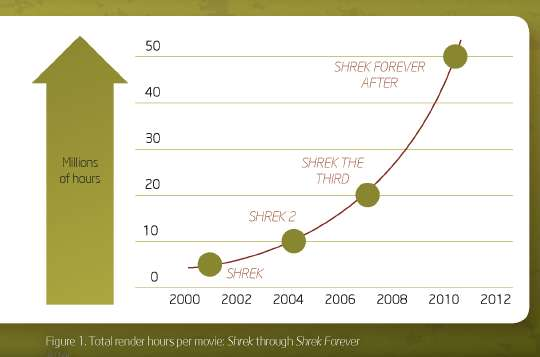With all the advancement in computer technology, one would have thought that animated movies would nowadays required less time in rendering than, for example, 15 years ago, right?
Well, no. It’s actually the quite opposite and a perfect example is what producers call “The Shrek’s law” as each new Shrek movie needed double the time for rendering than the previous one.
Despite the advances in computing power from 2001 and onwards, the increasing usage of high-tech techniques like global illumination, physics simulation, and 3D demanded ever more CPU hours to render the films. DreamWorks Animation calls this the “Shrek’s Law,” a tongue-in cheek corollary to Moore’s Law*. According to Shrek’s Law, the CPU render hours needed to complete production on a theatrical sequel will double compared to the amount of time needed on the previous film. Here’s the relevant graph: (the article continues after the ad)

Photo: Intel
This law has proven itself true on the Shrek movies: In 2001, Shrek required approximately 5 million CPU render hours. In 2004, Shrek 2 required over 10 million CPU render hours. In 2007, Shrek the Third required over 20 million CPU render hours. Finally, the 2010 3D release of Shrek Forever After topped the charts at more than 50 million CPU render hours.
* Moore’s law refers to an observation made by Intel co-founder Gordon Moore in 1965. He noticed that the number of transistors per square inch on integrated circuits had doubled every year since their invention.
If you like what you read, then you will definitely love this one: Why Almost Every Movie Ends With The “This Is A Work Of Fiction” Disclaimer?


Photo: Damian Dovarganes / Associated Press, www.tokeofthetown.com
Photoshop: I’m A Useless Info Junkie
Widget not in any sidebars






